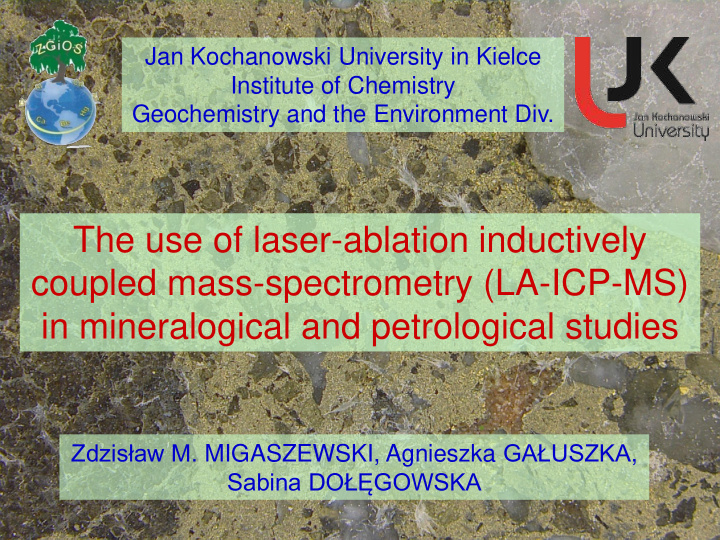



Jan Kochanowski University in Kielce Institute of Chemistry Geochemistry and the Environment Div. The use of laser-ablation inductively coupled mass-spectrometry (LA-ICP-MS) in mineralogical and petrological studies Zdzisław M. MIGASZEWSKI, Agnieszka GAŁUSZKA , Sabina DOŁĘGOWSKA
What is LA-ICP-MS? Laser-ablation inductively coupled-mass spectrometry (LA- ICP-MS) is an analytical technique to determine trace elements at ppb levels in geologic and biologic solid microsamples. The mineral grains or plant tissues are viewed through a microscope and the sample surface is ablated with a fine pulsed laser beam. The laser shots create the sample aerosol which is swept directly into the inductively coupled argon plasma (ICP). Argon plasma at ~6000K (5727 C) vaporizes sample and ionizes elements contained in sample aerosol. Mass Spectrometer separates and measures number of ions of an element at each mass generated by the ICP ion source.
Based on W.I. Ridley and F.E. Lichte (1998)
LA-ICP-MS ELAN DRC II, Perkin Elmer
LSX-500 CETAC laser ablation module [Nd:YAG (neodymium: yttrium-aluminum garnet) laser, 266 nm]
What are Laser Ablation System Capabilities? In-situ trace element measurements directly from solids. Microscale trace element mapping of polished thin sections or rough samples. Rapid, multi-element determinations with sub-ppm limit of detection. Minimal or no sample preparation required. Spatial relationship or phase association characterized at high spatial resolution. Qualitative to fully quantitative determinations. Capable of <5% RSD precision.
Laser Ablation ICP-MS can be considered the trace element laser microprobe. LA-ICP-MS is comparable to Electron Probe Microanalysis (EPMA) and Secondary Ion Mass Spectrometry (SIMS). Compared to EPMA and SIMS, LA-ICP-MS reveals less spatial resolution (lower magnification capabilities), but a few significant benefits: no sample preparation; significantly improved trace element sensitivity; decreased matrix dependence; flexible sample ablation chamber for various sample geometries.
Limitations (Achilles heel) Laser ablation requires matrix matched reference materials. Differences in reporting results due to using different lasers and standards. Major developments for ICP-MS instrumentation do not address specific needs of laser ablation. The laser must produce particles of the exact chemistry of the target sample (so no melting or fractionation). The ICP-MS needs small droplets from the nebulizer, so the laser has to produce small particles. The laser must ablate the sample in the same way as the calibration material.
Comparison with other techniques Technique Strengths Weaknesses Comments Rapid with no sample Lack of reference preparation, capable of materials, matrix LA-ICP-MS sub- ppm detection, dependance, semi- spatial information destructive High spatial resolution, Sensitivity is limited non-destructive, below 100 ppm, Electron surface analysis, easy interferences can microprobe to calibrate be challenging Sensitivity and spatial Expensive and Ion resolution, capable of slow, matrix microprobe isotopic analyses, dependence Ultra-trace detection, Time consuming Validated and Bulk well validated and and difficult accepted for Analysis accepted preparation, no regulatory and spatial information legal situations Alan Koenig, Todor Todorov (2009)
Petrographic study of a sample should be performed prior to LA analysis SEM and/or electron microprobe study need to be made for inclusion characterization and/or elemental zoning info
Stereoscopic image of the quartzite-quartz-pyrite breccia of the Podwiśniówka quarry (near Kielce, Holy Cross Mts)
Pyrite grains within quartz matrix (transmitting light, crossed nicols)
Pyrite grains within quartz matrix (reflected light, crossed nicols)
As-rich pyrite 20 µm SEM image of a pyrite grain
USGS Microanalytical Reference Materials (dr Steve Wilson): Glass BCR-2G, Basalt glass BHVO-2G, Basalt glass BIR-1G, Table Mountain Basalt Glass, Basalt Glass TB-1G, Synthetic basalt GSD-1G, Nephelinite Knippa Texas NKT- 1G, Carbonate MACS-3 and GPVI, Polymetal sulfide MASS-1; NIST 612 Glass
Striped chert from Ożarów (NE Holy Cross Mts, Poland) 80 ppb 70 60 Single line raster 50 40 Ce 30 U 20 10 0 1 2 3 4 5 6 7 8 9 10 11 12 13 14 15 Rastering points
3000 ppb 2500 2000 1500 Single line raster 1000 500 Ni Pb 0 1 2 3 4 5 6 7 8 9 10 11 12 13 14 15 Rastering points
Cu, Mn and Pb in silicified wood from Włoszczowice -Karsy (southern part of HCM) Cu Mn Pb ppm 27 16 55 31 8 34 8 8 38
1 10 Quartz-quartzite- pyrite breccia of Podwiśniówka near Kielce (HCM)
Concentrations of selected elements in pyrite cement of quartz- quartzite breccia of Podwiśniówka Ag As Cd Co Cu Mo Ni Pb Zn Point ppm 1 0.14 37963 25 56 47 2 126 28 418 2 1.07 396 25 1 73 1 2 36 421 3 0.33 4929 25 18 49 0 33 2 420 4 1.08 379 25 1 73 1 2 37 422 5 0.47 6581 25 1 43 0 9 28 421 6 0.04 28386 25 17 48 1 66 25 422 7 2.20 50465 25 20 7 4 153 30 420 8 0.33 18271 25 19 52 0 82 30 421 9 1.30 82264 25 58 40 8 229 25 416 10 0.66 43353 25 33 29 4 159 20 420
Trace element maps of garnet 9000 9000 Ti Sm 8000 8000 7 ppm 1000 ppm 900 ppm 7000 7000 6 ppm 800 ppm 6000 6000 5 ppm 700 ppm microns microns 600 ppm 5000 5000 4 ppm 500 ppm 4000 4000 3 ppm 400 ppm 3000 3000 300 ppm 2 ppm 200 ppm 2000 2000 1 ppm 1000 1000 0 0 0 1000 2000 3000 4000 5000 6000 7000 8000 9000 10000 0 1000 2000 3000 4000 5000 6000 7000 8000 9000 10000 microns microns Yb/Sm 9000 9000 Yb 8000 150 8000 350 ppm 140 130 7000 7000 300 ppm 120 110 6000 6000 250 ppm 100 microns microns 90 200 ppm 5000 5000 80 70 150 ppm 4000 4000 60 50 100 ppm 3000 3000 40 30 50 ppm 2000 2000 20 1000 1000 0 0 0 1000 2000 3000 4000 5000 6000 7000 8000 9000 10000 0 1000 2000 3000 4000 5000 6000 7000 8000 9000 10000 microns microns Courtesy of Alan Koenig
Recommend
More recommend